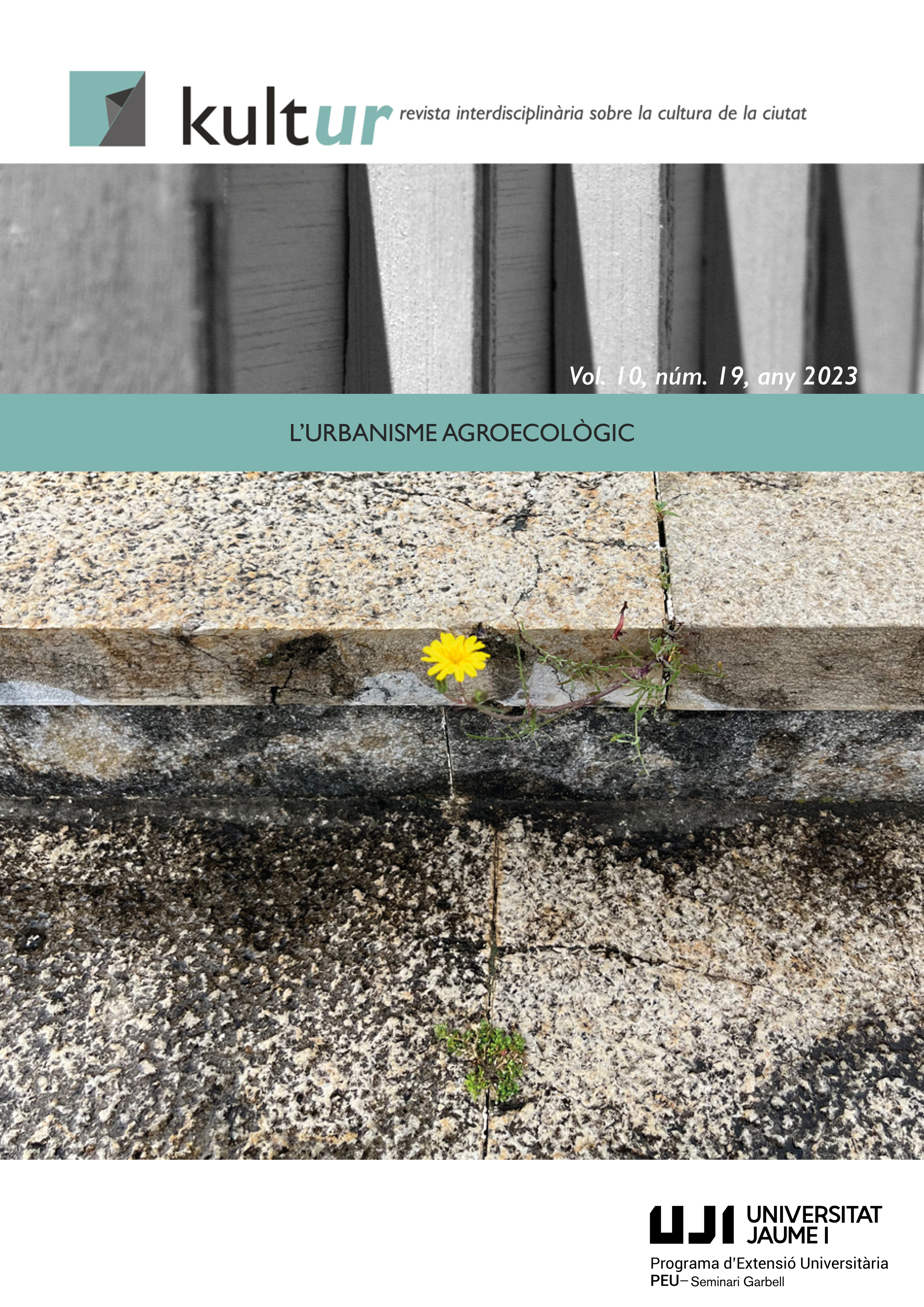Cultivando malas hierbas. Biodiversidad, diseño, cultura y percepción
Main Article Content
Abstract
La idea de “mala yerba” aparece ya en el texto del “Tratado de Agricultura General” de Gabriel Alonso de Herrera de 1513 como un tema recurrente en el cultivo de cosechas, junto con las plagas de orugas e insectos, entro los muchos males que amenazaban entonces la agricultura. Herrera delimitaba así en su texto las buenas prácticas del agricultor de la época, que incluían la introducción de un orden extremo en la apariencia d ellos campos, al tiempo que delimitaba el que será el principal campo de batalla de la guerra ser humano contra la naturaleza, la producción de alimentos.
Downloads
Article Details
All the contents of kult-ur journal are distributed under the Creative Commons Attribution-ShareAlike 4.0 International (CC BY-SA 4.0), unless otherwise indicated. Click to see basic information and the legal text of the license. The indication of this license CC BY-SA 4.0 must be expressly stated in this way when necessary.
References
Bonthoux, S., Voisin, L., Bouché-Pillon, S., Chollet, S. More than weeds: Spontaneous vegetation in streets as a neglected element of urban biodiversity, Landscape and Urban Planning, Volume 185, 2019, Pages 163-172, ISSN 0169-2046, https://doi.org/10.1016/j.landurbplan.2019.02.009
Borysiak J, Stępniewska M. Perception of the Vegetation Cover Pattern Promoting Biodiversity in Urban Parks by Future Greenery Managers. Land. 2022; 11(3):341. https://doi.org/10.3390/land11030341
Burgen, Stephen. Bat boxes, ‘greened’ streets and bug hotels: Barcelona embraces its wild side. The age of extinction. The Guardian. 31 Jan 2021 12.30 GMT. Consultado el 19 de abril de 2023. Disponible en línea en: https://www.theguardian.com/environment/2021/jan/31/bat-boxes-greened-streets-and-insect-hotels-barcelona-embraces-its-wild-side-aoe
de la Fuente de Val, Gonzalo. Modelos de Naturalización Urbana y Preferencias Paisajísticas por Ciudadanos y Técnicos Municipales en América Latina. Ciudad y territorio, estudios territoriales, Vol. LIV, Nº 211, primavera 2022, Págs. 181-198. ISSN(P): 1133-4762; ISSN(E): 2659-3254. https://doi.org/10.37230/CyTET.2022.211.10
Escuer Constante, Lorena. Biodiversidad funcional urbana: Estrategias para la conservación de la fauna auxiliar. La Cultura del Árbol. Nº86 ABR 2020. p. 36-40.
Escuer Constante, Lorena y Carballo Pérez, Gabino. ¿Dónde reside la naturaleza? Biodiversidad funcional en los espacios verdes urbanos. Revista PARJAP: Boletín de la Asociación Española de Parques y Jardines, ISSN 1699-3349, Nº. 91, 2018, págs. 6-16
González Ortiz, V., (2016) 100 medidas para la conservación de la biodiversidad en entornos urbanos. SEO/BirdLife, Madrid. Consultado el 19 de abril de 2023. Disponible en línea en: https://www.seo.org/wp-content/uploads/2020/02/100medidas_biodiversidad_urbana.pdf
Herrera, Alonso de. Agricultura General Corregida Segun El Testo Original De La Primera Edicion Publicada en 1513 Por El Mismo Autor Y Adicionada Por La Real Sociedad Economica Matritense. Consultado el 19 de abril de 2023. Disponible en: https://bibdigital.rjb.csic.es/records/item/9699-agricultura-general-de-gabriel-alonso-de-herrera-tomo-i
Horvath, David P., Clay, Sharon A., Swanton, Clarence J., Anderson, James V., Chao, Wun S. (2023) Weed-induced crop yield loss: a new paradigm and new challenges. Trends in Plant Science, Volume 28, Issue 5, 567-582. doi: 10.1016/j.tplants.2022.12.014
Kaplan, S. (1988). Perception and landscape: Conceptions and misconceptions. In J. Nasar (Ed.), Environmental Aesthetics: Theory, Research, and Application (pp. 45-55). Cambridge: Cambridge University Press. doi:10.1017/CBO9780511571213.006
Langemeyer, J., Calcagni, F., Baró, F. Mapping the intangible: Using geolocated social media data to examine landscape aesthetics, Land Use Policy, Volume 77, 2018, Pages 542-552, ISSN 0264-8377, https://doi.org/10.1016/j.landusepol.2018.05.049.
Matesanz, S. y Valladares, F. (2009). Plantas ruderales, Una relación milenaria de amor y odio que genera conocimiento, problemas y desafíos. Investigación y Ciencia, 390, 10-11. Consultado el 19 de abril de 2023. Disponible en: https://old.valladares.info/pdfs/Matesanz%20Valladares%202009%20Plantas%20ruderales%20Inv%20Ciencia.pdf
Müller SM, Peisker J, Bieling C, Linnemann K, Reidl K, Schmieder K. The Importance of Cultural Ecosystem Services and Biodiversity for Landscape Visitors in the Biosphere Reserve Swabian Alb (Germany). Sustainability. 2019; 11(9):2650. https://doi.org/10.3390/su11092650
Nassauer, Joan Iverson. Messy Ecosystems, Orderly Frames. Landscape Journal, vol. 14, no. 2, 1995, pp. 161-170. http://hdl.handle.net/2027.42/49351
Phillips, D., Lindquist, M. Just weeds? Comparing assessed and perceived biodiversity of urban spontaneous vegetation in informal greenspaces in the context of two American legacy cities, Urban Forestry & Urban Greening, Volume 62, 2021, 127151, ISSN 1618-8667, https://doi.org/10.1016/j.ufug.2021.127151.
Repton, Humphry (1795) Sketches and hints on landscape gardening: collected from designs and observations now in the possession of the different noblemen and gentlemen for whose use they were originally made: the whole tending to establish fixed principles in the art of laying out ground. (en Loudon, J. C., (1840) The landscape gardening and landscape architecture of the late Humphrey Repton, esq., being his entire works on these subjects, pág. 101) https://archive.org/details/landscapegarden02loudgoog/page/n140/mode/2up
Schnugg, C. (2019). Creating ArtScience collaboration: Bringing value to organizations. Berlin: Springer, p. 37. DOI: 10.1007/978-3-030-04549-4
Villena, Marta. Desbrozar o conservar, las respuestas de las ciudades a la flora ‘rebelde’ que brotó en el confinamiento. El País. 8 JUN 2020 - 07:36 CEST. Consultado el 19 de abril de 2023. Disponible en línea en: https://verne.elpais.com/verne/2020/06/04/articulo/1591267483_291097.html



.png)